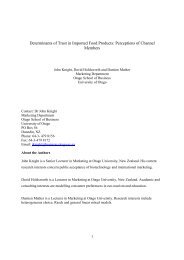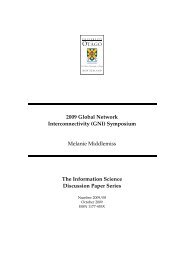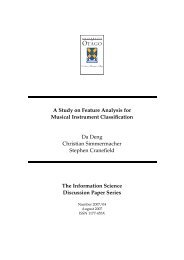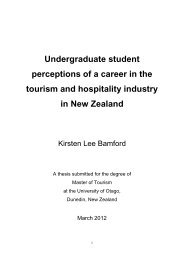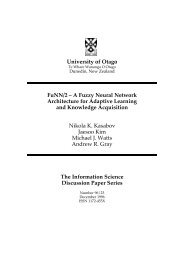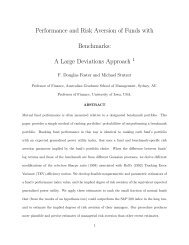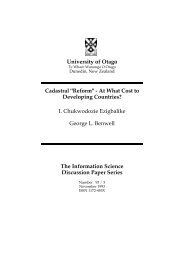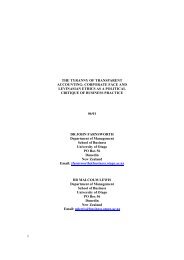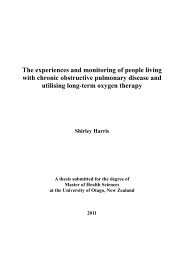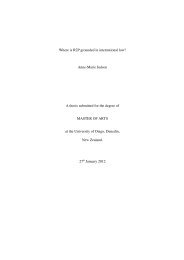Reframing perceptions of anthropomorphism in wildlife film and ...
Reframing perceptions of anthropomorphism in wildlife film and ...
Reframing perceptions of anthropomorphism in wildlife film and ...
You also want an ePaper? Increase the reach of your titles
YUMPU automatically turns print PDFs into web optimized ePapers that Google loves.
<strong>of</strong> <strong>anthropomorphism</strong> as bow<strong>in</strong>g to the social norms <strong>of</strong> an audience, Orangutan Isl<strong>and</strong><br />
provides evidence that the ends may justify the means. The anthropomorphic model<br />
may have the potential to reshape an audience‘s behaviour <strong>and</strong> elicit positive<br />
conservation action.<br />
Provid<strong>in</strong>g a counter-argument <strong>in</strong> his sem<strong>in</strong>al work Wildlife Film, Bousè (2000) suggests<br />
that the actual <strong>in</strong>fluence <strong>of</strong> <strong>wildlife</strong> <strong>film</strong> on audiences‘ values <strong>and</strong> beliefs, despite rat<strong>in</strong>gs<br />
or box-<strong>of</strong>fice figures, rema<strong>in</strong>s immeasurable. He further suggests that:<br />
‗Arguments that <strong>wildlife</strong> <strong>film</strong>s directly help save nature nearly all rest on<br />
anecdotal evidence as well as a failure to consider sampl<strong>in</strong>g procedures,<br />
viewers dispositions <strong>and</strong> the difficulty <strong>of</strong> actually measur<strong>in</strong>g effectiveness‘.<br />
There is a dearth <strong>of</strong> real evidence <strong>in</strong> the literature determ<strong>in</strong><strong>in</strong>g direct l<strong>in</strong>ks between<br />
<strong>in</strong>fluential <strong>film</strong>mak<strong>in</strong>g techniques, such as <strong>anthropomorphism</strong>, <strong>and</strong> any def<strong>in</strong>ite<br />
causative effects. Bousè‘s claims, however, are perhaps unsubstantiated given the very<br />
lack <strong>of</strong> evidence he mentions. Further research is needed to accurately determ<strong>in</strong>e the<br />
<strong>in</strong>fluences <strong>of</strong> <strong>anthropomorphism</strong> beyond the anecdotal evidence. Certa<strong>in</strong>ly<br />
anthropomorphic techniques play a part <strong>in</strong> provid<strong>in</strong>g enterta<strong>in</strong><strong>in</strong>g, viewer-friendly<br />
<strong>wildlife</strong> television <strong>and</strong> <strong>film</strong>mak<strong>in</strong>g. K<strong>in</strong>g (1996) argues that l<strong>in</strong>k<strong>in</strong>g the audience with<br />
the stories on screen allows them to feel that they are <strong>in</strong>tr<strong>in</strong>sically connected to the<br />
<strong>wildlife</strong> <strong>and</strong> nature represented, that they are <strong>in</strong>volved <strong>in</strong> their lives or have been there<br />
before. Once connected to these animals or l<strong>and</strong>scapes, audiences are more likely to<br />
have a personal <strong>in</strong>vestment <strong>in</strong> their <strong>in</strong>terests or conservation. As Dioum (1968) said<br />
‗We will conserve only what we love…‘ By simply reach<strong>in</strong>g larger audiences through<br />
their enterta<strong>in</strong><strong>in</strong>g anthropomorphic narrative structures, <strong>and</strong> <strong>in</strong>creas<strong>in</strong>g audience‘s<br />
empathy <strong>and</strong> underst<strong>and</strong><strong>in</strong>g with appeal<strong>in</strong>gly anthropomorphised characters, series like<br />
Orangutan Isl<strong>and</strong> <strong>and</strong> <strong>film</strong>s like March <strong>of</strong> the Pengu<strong>in</strong>s may have huge potential impact<br />
on audiences‘ conservation values <strong>and</strong> <strong>in</strong>spire positive environmental change.<br />
30




